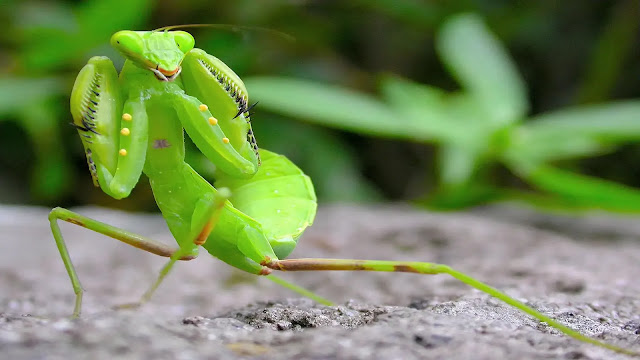One of the most fascinating insects in the world is the praying mantis. Not only do they appear fascinating, with their distinctive forelegs tucked up underneath their heads as if they’re praying, they're the same facts regarding mantis.
1 - Mantids will flip their heads a full 180 degrees.
1 - Mantids will flip their heads a full 180 degrees.
If you try to see a mantis, you'll be surprised when it's over your shoulder. No different insect will do so. Praying mantids have a versatile joint between the pinnacle and thorax that allows them to swivel their heads. This ability, along with their rather automaton faces and long, grasping forelegs, endears them to even the most entomophobic individuals among us.
2 - They have a nice vision.
Praying mantises possess stereo vision, and due to the location of their eyes, they even have a large field of vision. Every one of their eyes features a fovea—a focused space of photoreceptor cells that lets them focus and track with acuity. Not only will mantises see in three dimensions, but analysis has revealed that their three-dimensional vision differs from that of all previously notable forms in nature. Except for revealing additional details regarding mantises themselves, this might facilitate scientists developing higher vision in robots.
3 - The mantis has a weak sense of hearing.
3 - The mantis has a weak sense of hearing.
While it's an advanced sight, praying mantises can’t hear like most insects do. Instead, a mantis will solely sense vibrations. This carnivorous insect has "ears" in the middle of its abdomen that can detect high-pitched tones from bats.
4 - The white praying mantis looks like a phase.
4 - The white praying mantis looks like a phase.
After every molt that nymphs bear before reaching adulthood, the mantis turns pure white and appears like an anomaly. Nonetheless, this stage of the white mantis is brief and quickly darkens into inexperienced or brown.
5 - They make swift work of their prey.
Praying mantises wait to ambush or stalk their prey, but once they’re able to strike, they do so with lightning speed, striking with those massive front legs so quickly it’s arduous to check with the oculus. Additionally, they need spikes on their legs to skewer and pin the victims into place.
You Might Also Enjoy This.
6 - A mantis bite isn't toxic.
This insect has no venomous species and is often tired of humans. Instead, the mantis uses the spikes on its forelegs to safeguard itself. Also, it doesn't have any stingers.
7 - Mantids can be pest controllers.
Mantids are quite helpful animals in the sense that they eat all types of insects, including harmful pests. Thus, the population of those harmful pests is reduced, which keeps the total system healthy and balanced.
8 - The male praying mantis is eaten by its mate.
8 - The male praying mantis is eaten by its mate.
It is believed that up to 28% of the males in praying mantis species known to engage in sexual cannibalism are consumed by their mates. The female retains the male's sperm after mating and uses it later to fertilize the eggs she makes.
9 - They are associated with termites and cockroaches.
Although they're not wanted like that, mantids are closely associated with cockroaches and, additionally, with termites. However, there's no peace between those species. They even fight against one another and regard one another as prey from time to time, betting on the geographic area.
10 - The orchid mantis has a body made of orchid flowers.


.webp)
.webp)
.webp)
.webp)
.webp)
.webp)
.webp)
.webp)
